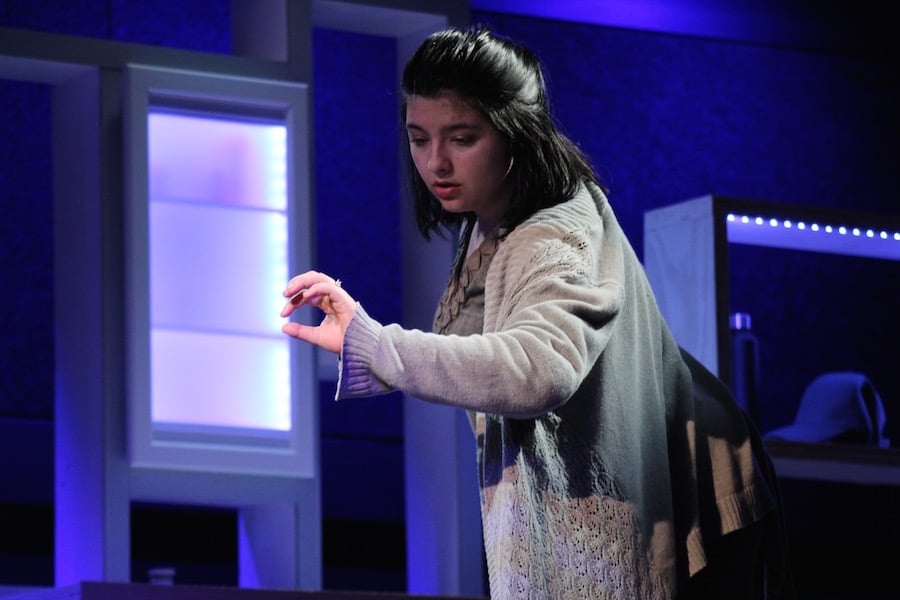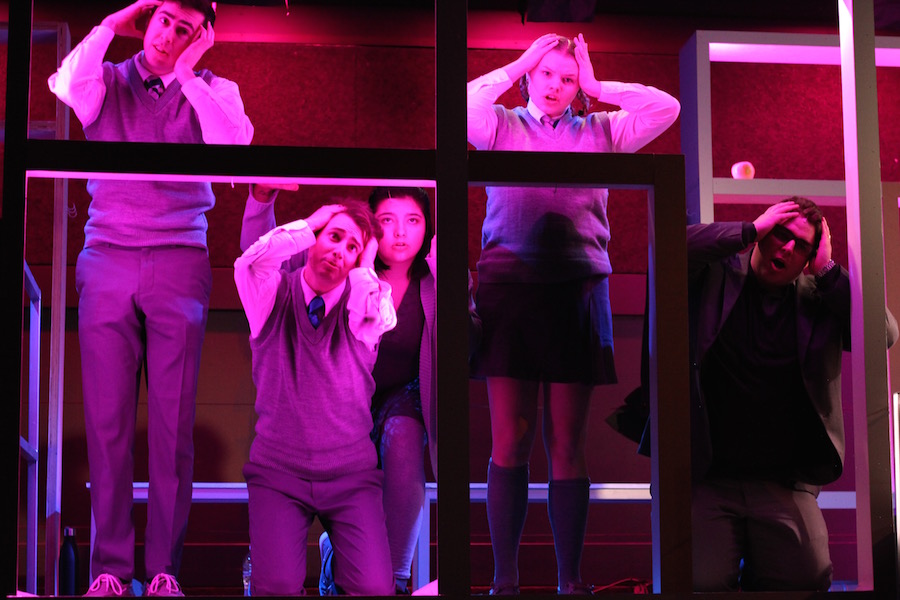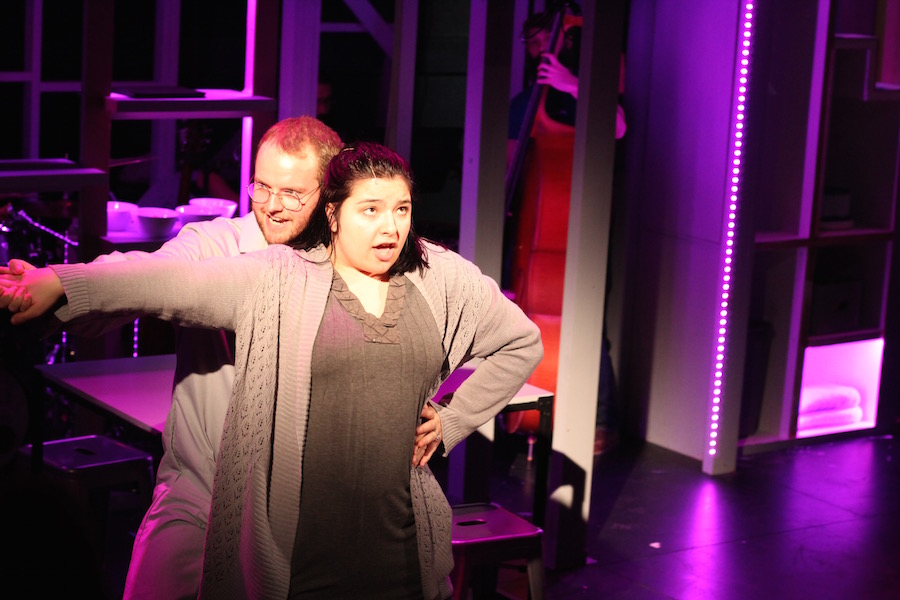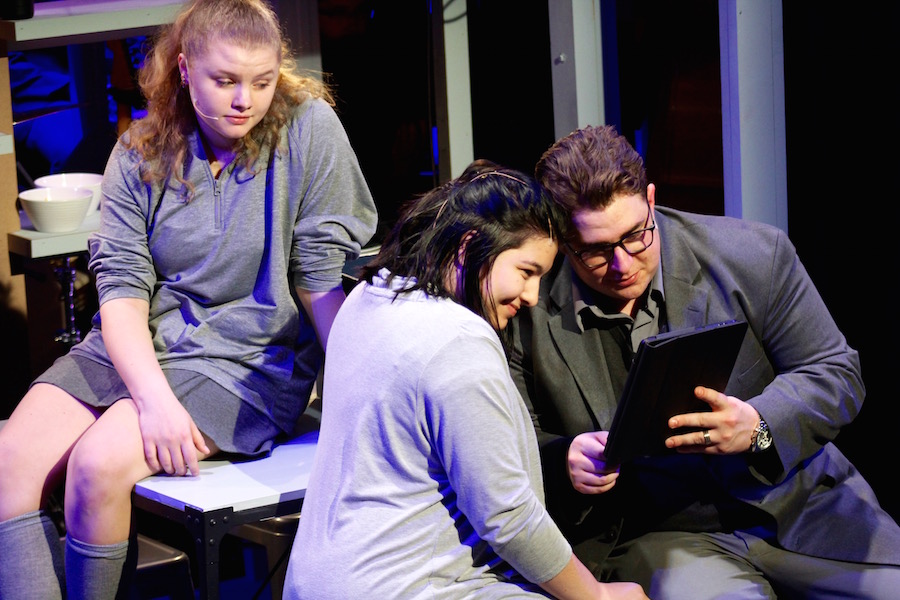
Hamden | Arts & Culture | Musical Theater | Quinnipiac University

| Kayla Jarry as Diana in Next To Normal at Quinnipiac University. Lucy Gellman Photos. |
A mother stands over a toilet with her teenage son behind her, hands tight around a bouquet of plastic orange bottles. Her black hair shines oily around her face. His eyes, tracking her, are wild and wet. The pills fly: pearlescent purple and white and yellow and green as they sail from the bottles to the glistening bowl below. We don’t know the names of the drugs or of the boy, but there’s a sense that we did, once upon a time not so long ago.
“And I miss the mountains/I, I miss the lonely climb,” she belts. “Wandering through the wilderness./And spending all my time/Where the air is clear/And cuts you like a knife.”
Her plight—and perhaps also her pills—lies at the arrhythmic heart of Next to Normal, running at Quinnipiac University’s Theatre Arts Center from Feb. 27 to March 3. The rock musical, which won a 2010 Pulitzer Prize for drama, dives deep into the realm of mental illness and addiction, pushing audiences to look into the overmedicated soul of this country and see what stares back at them. Tickets and more information here.

| From left to right: Sean Molicki, Louis Napolitano, Kayla Jarry, Sarah Cowden and Connor Whiteley. |
Written by Tom Kitt with book and lyrics by Brian Yorkey, Next To Normal fixes its reverb-drenched, stringed and humming lens on the Goodmans, a suburban family of four—or something like that—struggling with multiple layers of depression, delusion and buried grief. In a little house on a little street in a little suburb, Diana Goodman (Kayla Jarry) tries to navigate a years-long diagnosis of bipolar disorder, floundering as her psychopharmacologist prescribes, tinkers, prescribes again.
She is stalked, literally, by her grief, which threatens to dance her right out of this world and into the next. Around her, nothing is quite as steady as it seems—her husband Dan (a moving Connor Whiteley) is just one long conversation away from not keeping it together. Her daughter Natalie (Sarah Cowden) will be okay if her work can just catapult her into Yale, and she can leave everything behind. That, and if her brother Gabe (a particularly gifted and maniacal Louis Napolitano) can just leave the whole family alone after 16 torturous years.
It’s an emotional mess, zipped into something that is surprisingly contained. The musical cuts right to the core of overprescription, crippling sadness, and even the idea that therapy is a luxury that only the upper class gets to have. But it also prods at the many faces of addiction, legacy of loss, and gendered expectations that can be deadly. While Dan reckons with the exhausting costs of his masculinity, Diana and Natalie push hard at the edges of the feeble female narrative until it collapses to something much more interesting.

Suddenly, the choice to medicate or not to medicate seems so very heavy and confusing . If Klonopin is okay, what of Natalie’s sweet stoner boyfriend Henry (Sean Molicki)? Should we be any more careful with Xanax than we are with the energy drinks she pounds early each morning? How porous are the boundaries by which we numb ourselves after all?
Under the direction of Yale alum Rory Pelsue, cast members rise to that challenge. Our Diana is at her most dynamic in the piece’s moving “I Miss The Mountains” and “Make Up Your Mind/Catch Me I’m Falling,” mining her despair for momentum. She takes a minute to find her voice, but then it is muscled and afraid at once, and she does not let it go. Paul Zopatti is squirm-inducingly on brand as two of her white, male therapists, somewhere between a pharmaceutical robot and soft-spoken, slightly useless talk therapist as he jumps between characters.
A clean, boxy two-story set designed by Abigail Copeland almost becomes a character itself, cast members climbing its stairs, dancing through its boxy units, nearly falling from a roped-off section of its second floor. It has enough heart to hold every emotion as Natalie belts “Superboy And The Invisible Girl,” and can nearly breathe by the end of the show for the amount of pain and fury it too has had to absorb. Fluorescent pink, green and blue light soaks the characters, their choreography sharp and balletic as it puts cast members into orbit with each other like delicate, unsteadily bobbing planets.

But it is Napolitano as Gabe, a vestige of the past who won’t let go, who leaves us chilled and a little (okay, very) verklempt at the end of the performance. Riding every twist and slide in Yorkey’s score, Napolitano is nimble and sensitive, but also filled with the rage of someone who just doesn’t want to be forgotten.
He takes on the set like a jungle gym that was made for him, darting around cast members as his voice winds through everything and slips through Diana’s fingers. He knows how to make his eyes gleam and go dull in the same scene, particularly electric while sharing the stage with Whiteley.
What is scary, of course, is that there’s a Gabe lurking in all of us, waiting for the trigger that will loose him from the cozy and dark folds of our minds. Maybe it’s not Diana’s calculus—that the pills can be flushed, the razor blades procured, the treatment tweaked until it works. But we, too, must tiptoe around our triggers—whatever their names may be—before they destroy us. The problem is, if we don't deal with them they might destroy us too.

In the decade since it hit Broadway, Next to Normal has aged almost too well. A 2014 study from the National Center for Health Statistics showed antidepressant use in the United States began to soar at the end of the last century, up 65 percent between 1999 and the time the study ended 15 years later. Since announcing the musical, Theatre Program Director Kevin Daly said that psychology teachers have asked their students to attend performances. The cast also received a visit from a psychology professor, who spoke about how mental health practitioners reach diagnoses and prescribe medications or alternate treatments.
In the hazy blue of the post-show, we’re left with questions that are much bigger than this little cast, in this little building, in this little suburb of New Haven. Where is the gulf between those who need treatment and those who receive it? What does it mean to need treatment it in the first place? Who qualifies for healing, and who is past the point of no return?
Are we supposed to let all the pain in after all? Is it supposed to hurt this much?

